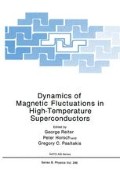Abstract
When the onsite correlation is strong, electrons can move by usual hopping only on to empty sites but they can exchange position with their neighbors by a correlated motion. The phase in the former process is fixed and it favors Bloch states. When the concentration of empty sites is small then the latter process dominates and we are free to introduce a phase provided it is chosen to be the same for ↑ and ↓-spin electrons. Since for a partly filled band of non-interacting electrons the introduction of a uniform commensurate flux lowers the energy, the correlated motion can lead to a physical mechanism to generate flux states. These states have a collective gauge variable which is the same for ↑ and ↓-spins and superconducting properties are obtained by expanding around the optimum gauge determined by the usual kinetic energy term. If this latter term has singularities at special fillings then these may affect the superconducting properties.
In its present stage the theory predicts orbital currents which result in a distribution of magnetic fields at crystallographically equivalent sites. Such fields are not observed experimentally.
Access this chapter
Tax calculation will be finalised at checkout
Purchases are for personal use only
Preview
Unable to display preview. Download preview PDF.
References
Y. Hasegawa, P. Lederer, T. M. Rice and P. B. Wiegmann, Phys. Rev. Lett., 63, 907, (1989)
P. Lederer, D. Poilblanc and T. M. Rice, Phys. Rev. Lett., 63, 1519, (1989)
I. Affleck and B. J. Marston, Phys. Rev. B 37, 3774, (1988)
I. Affleck, Z. Zou, T. Hsu and P. W. Anderson, Phys. Rev. B 38, 745, (1988)
V. Kalmeyer and R. B. Laughlin, Phys. Rev. Lett. 59, 2995, (1987)
R. B. Laughlin, Phys. Rev. Lett. 60, 2677, (1988)
P. B. Wiegmann, Phys. Rev. Lett. 60, 821, (1988);
P. B. Wiegmann, Physica Scripta T 27, 160 C (1988)
X. G. Wen and A. Zee, ITP preprint (1989)
N. Read, Phys. Rev. Lett. 62, 86, (1989);
see also S. M. Girvin and A. H. Mac Donald, Phys. Rev. Lett. 58, 1252, (1987)
Dung-Hai Lee and Matthew P. A. Fisher, Phys. Rev. Lett. 63, 903, (1989)
F. C. Zhang, C. Gros, T. M. Rice and H. Shiba, Supercond. Sei. Technol. 1, 36, (1988)
G. Montambaux, Phys. Rev. Lett. (C), 63, 1657, (1989)
P. W. Anderson, Science 235, H96, (1987)
F. C. Zhang and T. M. Rice, Phys. Rev. B 37. 3759, (1988)
Various authors in those Proceedings discuss the phase separation which occurs in the t—J model. This phenomenon was discussed some time ago in connection with the physics of bcc 3He in the mK range. The point of view in this paper is that phase separation, which is possible for uncharged fermion crystals is inhibited by Coulomb forces in doped Mott insulators. See G. Montambaux, M. Héritier and P. Lederer, J. Low Temp. Phys., 47, 39, (1982)
P. W. Anderson, B. S. Shastry and D. Hristopoulos, Princeton preprint (1989)
D. Poilblanc, ETH, preprint (1989)
S. Teitel and C. Jayaprakash, Phys. Rev. Lett. 51, 1999, (1983)
S. Teitel and C. Jayaprakash, Phys. Rev. B 27. 598, (1983)
T. C. Halsey, Phys. Rev. B 31. 5728, (1985)
J. Villain, J. Phys. C: Solid State Phys. 10, 1717, (1977)
I am indebted to N. Papanicolaou for a helpful remark on that point
X. G. Wen, F. Wylczek, A. Zee, Phys. Rev. B 39. 11413, (1989)
T. M. Rice, P. Lederer, D. Poilblanc, ETH Preprint, (1989)
Y. H. Chen, F. Wilczek, E. Witten, B. I. Halperin, IAZSSNS-HEP-89/27, preprint
B. I. Halperin, J. March-Russel and F. Wilczek, HUTP-89/A010, preprint
R. F. Kiefl et al., Phys. Rev. Lett. 63, 2136, (1989)
See also the variational Monte-Carlo results by Shoudan Liang and Nandini Trivedi, preprint
Y. Hasegawa and D. Poilblanc, preprint
F. C. Zhang, preprint
Author information
Authors and Affiliations
Editor information
Editors and Affiliations
Rights and permissions
Copyright information
© 1991 Plenum Press, New York
About this chapter
Cite this chapter
Lederer, P. (1991). Correlated Electron Motion, Flux States and Superconductivity. In: Reiter, G., Horsch, P., Psaltakis, G.C. (eds) Dynamics of Magnetic Fluctuations in High-Temperature Superconductors. NATO ASI Series, vol 246. Springer, Boston, MA. https://doi.org/10.1007/978-1-4684-7490-9_22
Download citation
DOI: https://doi.org/10.1007/978-1-4684-7490-9_22
Publisher Name: Springer, Boston, MA
Print ISBN: 978-1-4684-7492-3
Online ISBN: 978-1-4684-7490-9
eBook Packages: Springer Book Archive

